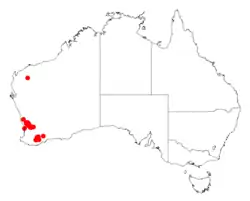Acacia crassistipula
| Acacia crassistipula | |
|---|---|
| Scientific classification | |
| Kingdom: | Plantae |
| Clade: | Tracheophytes |
| Clade: | Angiosperms |
| Clade: | Eudicots |
| Clade: | Rosids |
| Order: | Fabales |
| Family: | Fabaceae |
| Subfamily: | Caesalpinioideae |
| Clade: | Mimosoid clade |
| Genus: | Acacia |
| Species: | A. crassistipula
|
| Binomial name | |
| Acacia crassistipula | |

| |
| Occurrence data from AVH | |
| Synonyms[1] | |
| |
Acacia crassistipula is a species of flowering plant in the family Fabaceae and is endemic to the south-west of Western Australia. It is a low-spreading, more or less compact shrub with leaf-like stipules, erect, narrowly oblong to narrowly elliptic phyllodes, spherical heads of golden yellow flowers and narrowly oblong, wavy or curved pods.
Description
Acacia crassistipula is a low-spreading, more or less compact shrub typically grows to a height of 15–50 cm (5.9–19.7 in) and has ribbed branchlets covered in fine, soft hairs. Its phyllodes are hairy, narrowly oblong to narrowly elliptic, 7–16 mm (0.28–0.63 in) long, 1.5–3 mm (0.059–0.118 in) wide and slightly S-shaped with a more or less hooked end. There is one vein on each surface of the phyllodes and obscure lateral veins. There are leaf-like stipules 2–7 mm (0.079–0.276 in) long at the base of the phyllodes. The flowers are borne in a spherical to slightly oblong head in axils on a peduncle 5–10 mm (0.20–0.39 in) long. Each head is 5–6 mm (0.20–0.24 in) in diameter with 27 to 33 densely arranged, golden yellow flowers. Flowering occurs from July to August and the pods are narrowly oblong, wavy or curved, up to 40 mm (1.6 in) long, 3–5 mm (0.12–0.20 in) wide and thinly leathery to crusty. The seeds are egg-shaped to widely elliptic, 2–3 mm (0.079–0.118 in) long and shiny dark brown.[2][3][4][5]
Taxonomy
Acacia crassistipula was first formally described in 1842 by the botanist George Bentham in Hooker's London Journal of Botany from specimens collected by James Drummond in the Swan River Colony.[6][7] The specific epithet (crassistipula) means 'a thick stipule'.[8]
Distribution and habitat
This species of wattle grows in sandy and lateritic, gravelly soils from around Mogumber in the north down near York in the south and between Borden, Tambellup and Nyabing in open heath and Eucalyptus wandoo woodland, in the Avon Wheatbelt, Jarrah Forest, Mallee and Swan Coastal Plain bioregions of south-western Western Australia.[3]
Conservation status
Acacia crassistipula is listed as "not threatened" by the Government of Western Australia Department of Biodiversity, Conservation and Attractions.[5]
See also
References
- ^ a b "Acacia crassistipula". Australian Plant Census. Retrieved 3 August 2025.
- ^ Maslin, Bruce R. Rogers, J.; Kodela, Phillip G.; Orchard, Anthony E. (eds.). "Acacia crassistipula". Flora of Australia. Australian Biological Resources Study, Department of Climate Change, Energy, the Environment and Water: Canberra. Retrieved 3 August 2025.
- ^ a b "Acacia crassistipula". World Wide Wattle. Western Australian Herbarium. Retrieved 27 June 2019.
- ^ "Acacia crassistipula". Australian Biological Resources Study. Retrieved 3 August 2025.
- ^ a b "Acacia crassistipula". FloraBase. Western Australian Government Department of Biodiversity, Conservation and Attractions.
- ^ "Acacia crassistipula". APNI. Retrieved 2 August 2025.
- ^ Bentham, George (1842). Hooker, William Jackson (ed.). "Notes on Mimoseae, with a synopsis of species". London Journal of Botany. 1: 326. Retrieved 3 August 2025.
- ^ George, Alex S.; Sharr, Francis A. (2023). Western Australian Plant Names and Their Meanings - A Glossary (fifth ed.). Kardinya: Four Gables Press. p. 174. ISBN 9780645629538.